Winter Recycling with KMI in Des Moines
BY Sandy Lender

Not every recycling project requires precision measuring and national specifications. Yet officials at the City of Des Moines know you might as well do a project right to give the end user the best repair for the best price point. Enter the use of additives to condition aged reclaimed asphalt pavement (RAP) and unused hot-mix asphalt (HMA) from previous paving seasons. Here’s how the city of Des Moines put its process to the test in spring 2019 when temperatures were low and the wind was breezy.
As contractors know, HMA isn’t available all year round in certain parts of North America. Des Moines is one of those parts. For the city workers who are responsible for maintaining streets, using material they already have on hand is a financially smart move. For the April 3, 2019, test project discussed herein, Street Supervisor Kevin Decker, Shawn Kannenberg and Josh Frey used stockpiled material as step one.
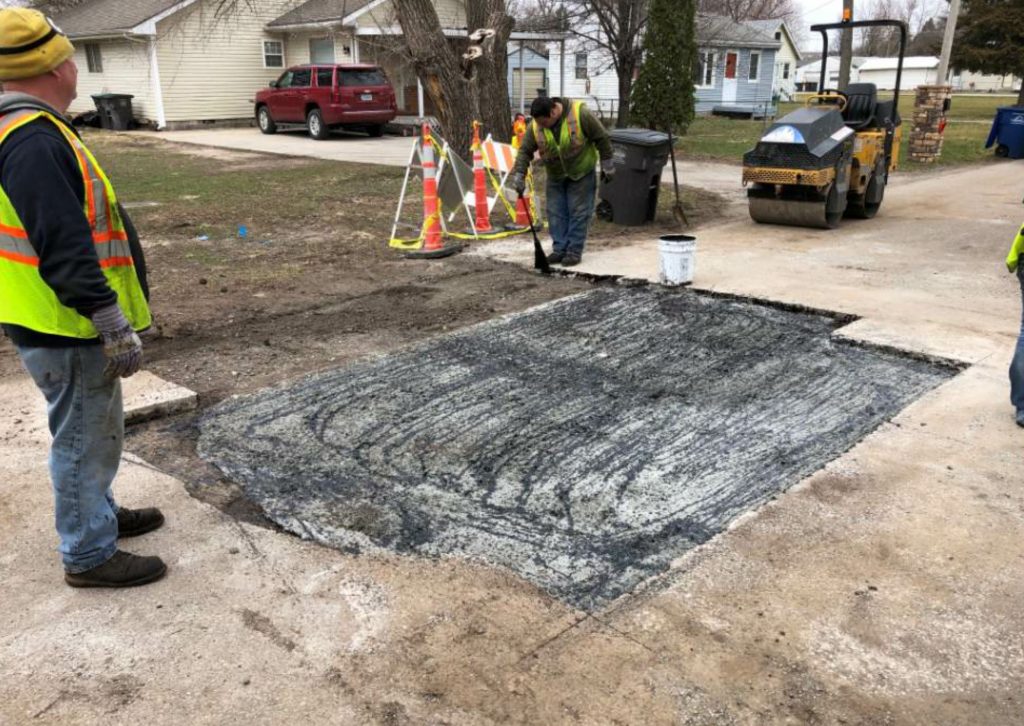
Here the City of Des Moines workers prepare the area to be patched at 112 E. 33rd Court with the batch of recycle material made with 1 gallon of CSS-1 tack and 1 gallon of Delta S rejuvenator. One worker paints the edge with tack while the hotbox is moved into place.
“HMA isn’t available at that time of year,” John Kida said. He’s the technical sales manager-midwest for Collaborative Aggregates, Wilmington, Massachusetts, and the individual who brought the Delta S rejuvenator to the test project for step 2. The city workers already add an emulsion liquid to their recycle material; Kida wanted to show them a better alternative. “They’ve already paid for the asphalt and millings that are stockpiled. The liquid materials only add about $25 per ton, so it is financially worth it.”
The reason to add liquid materials to the recycling process centers on oxidation and age. In the case of the stockpiled material Des Moines has on hand, Kida explained it’s mostly unused hot-mix gathered during the prior paving season.
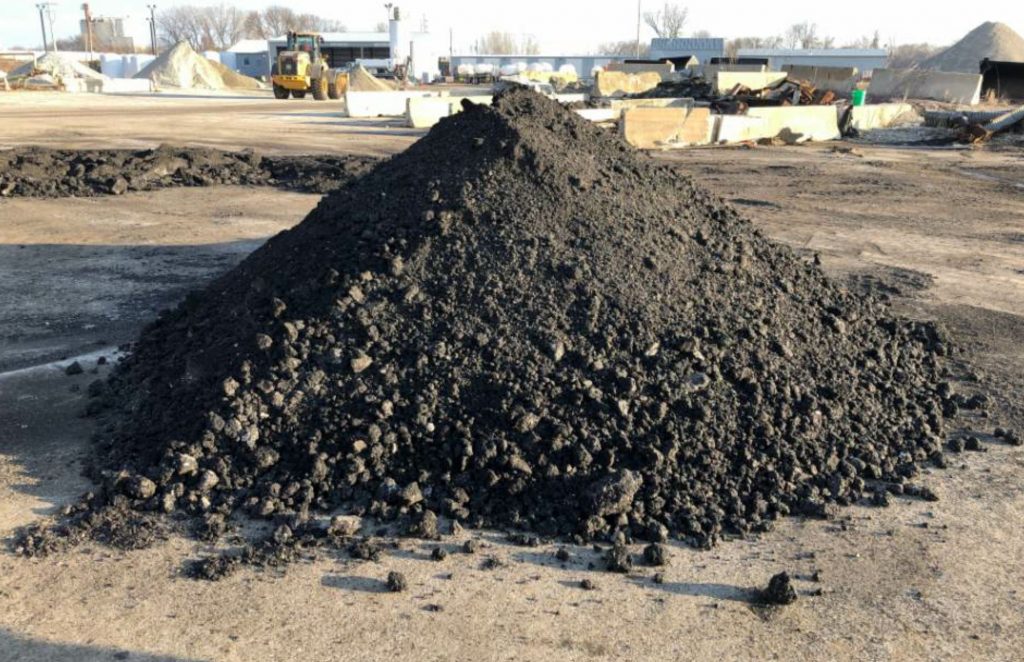
The City of Des Moines workers break up and crush their old millings and pavement chunks prior to recycling through the KM T-2.
“This material is spread out,” Kida said. “Then when it cools, they break it up and push it up into a pile. Using their own crusher, they will crush about 100 tons at a time to use in the recycler to patch potholes and utility cuts.”
The recycler the City of Des Moines uses is a KM T-2 Asphalt Recycler from KM International, North Branch, Michigan. It has a 2,600-pound capacity and can recycle up to 4 tons every hour for the workers. The recycle from the pile is loaded into the KM T-2 with a loader, and then, current practice for Des Moines is to add 1 gallon of CSS-1 tack emulsion to the unit. The unit recycles millings without direct flame impingement on the material, keeping emissions worries out of the picture. For the test project, the team made mix at about 20-25 minutes per batch, according to Kida.
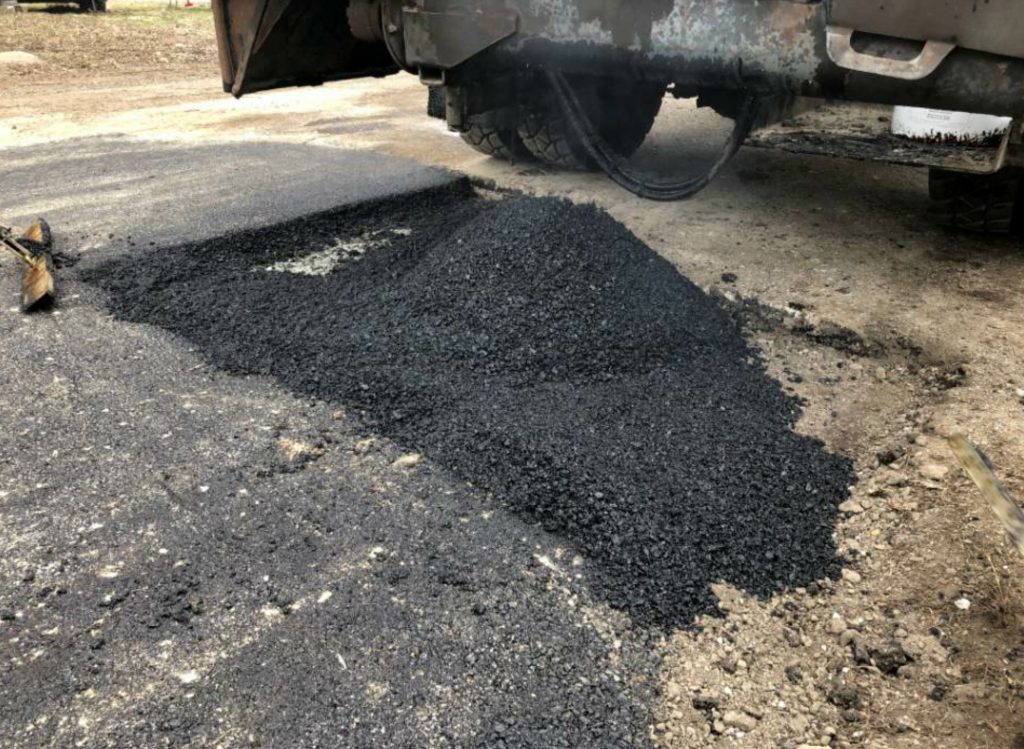
The final batch of recycle mix, containing 2 gallons of CSS-1 tack and 1 gallon of Delta S rejuvenator, is dumped out for raking into place at 112 E. 33rd Court. The workers saw no difference in workability and compaction between Batches 2 and 3.
Michael Blake, director of marketing for KM International, explained that the rotating drum and dump feature of the recycler are hydraulically controlled. Once the restored asphalt mix is ready, it’s poured into a loader, which feeds it into a 300 degrees F hotbox before being transported to the project site.
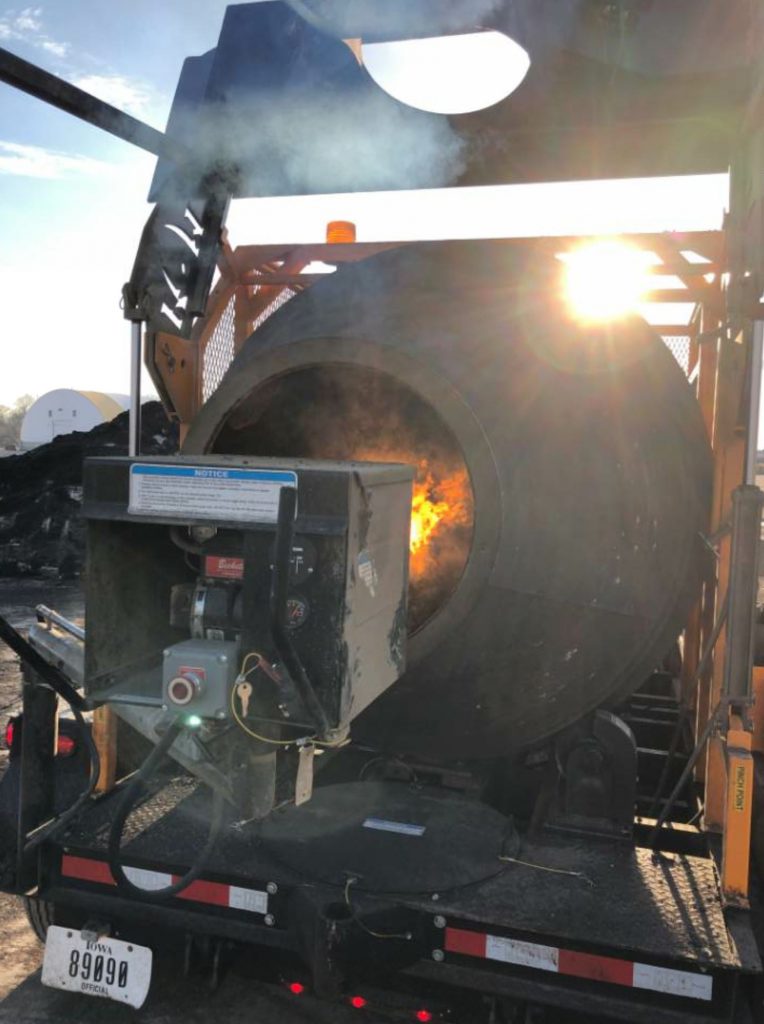
“We sell a PG64-22 in 3-gallon bags,” Blake said. “We recommend using 1 bag per load in the recycler. When you’re making mix in the T-2, the bag will melt during the agitation and the liquid will evenly encapsulate the aggregate. Our in-house testing has concluded that PG64-22 asphalt cement is the ideal additive for the mix design that goes into the T-2. The 3-pound bags meet the standard 3-5 percent mix design requirements for asphalt cement used at asphalt plants.”
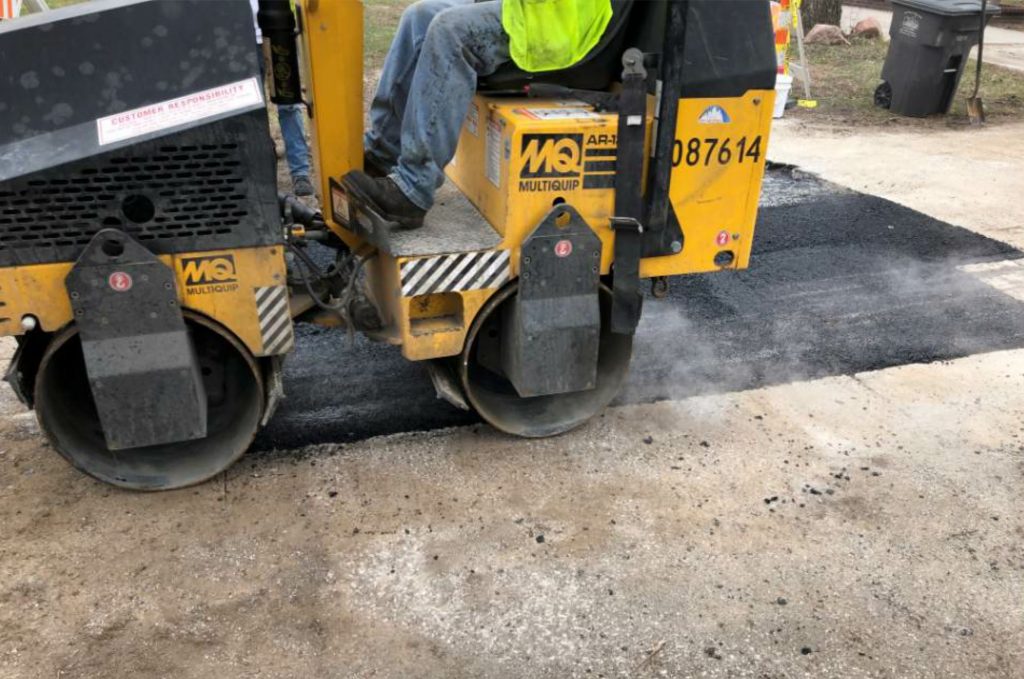
The second batch of recycle mix, containing 1 gallon of CSS-1 tack and 1 gallon of Delta S rejuvenator, is rolled nicely at 112 E. 33rd Court. The workers saw an improvement in workability and tightness of compaction when working with Batch 2 after working with the control batch.
The Delta S rejuvenator is a new concept. It has a flash point of 500 degrees F (260 degrees C), making it a viable candidate for introduction to the T-2’s drum. As mentioned above, there’s no flame impingement, but workers want to be aware of flash points when adding materials to elevated temperatures.
“Each unit comes with a hand-held infrared thermometer,” Blake said. “When the front of the unit is 300-350 degrees Fahrenheit, that’s when you introduce your additive. When the unit is 400 degrees in the front and 350 degrees in the back, the mix should be ready.”
For the test project this spring, City of Des Moines workers made a control batch of recycled mix treated with 1 gallon of CSS-1, heating it to approximately 340 degrees F. This mix was placed on a patch at 3301 Jefferson Street.

From left, Josh Frey and Shawn Kannenberg (with material), introduce the Delta S rejuvenator to the T-2 drum for restoring the binder in the recycle material. It is best to introduce additives when the front of the unit is measuring temperatures in the range of 300-350 degrees F, according to KM International’s Michael Blake.
During the project, the ambient temperature was 39oF and the sky was overcast. The site experienced 15 mph winds. Kida shared that the “mix appeared to be dull and very stiff.” He explained that while the mix compacted to an acceptable degree, it resulted in “a very open graded surface.”
The second batch included treatment with 1 gallon of CSS-1 and 1 gallon of Delta S rejuvenator, heating to a temperature between 300-340 degrees F. This mix was placed on a patch at 112 E. 33rd Court. During the project, the ambient temperature was 54 degrees F and the sky was overcast. The site again experienced 15 mph winds. Kida shared that the “mix coming out of the recycler had a nice sheen to it and was easier to move. Mix was coming out of the hotbox at 290 degrees F with a noticeable improvement in workability and compaction. The material was packed tighter and the surface was smoother.”
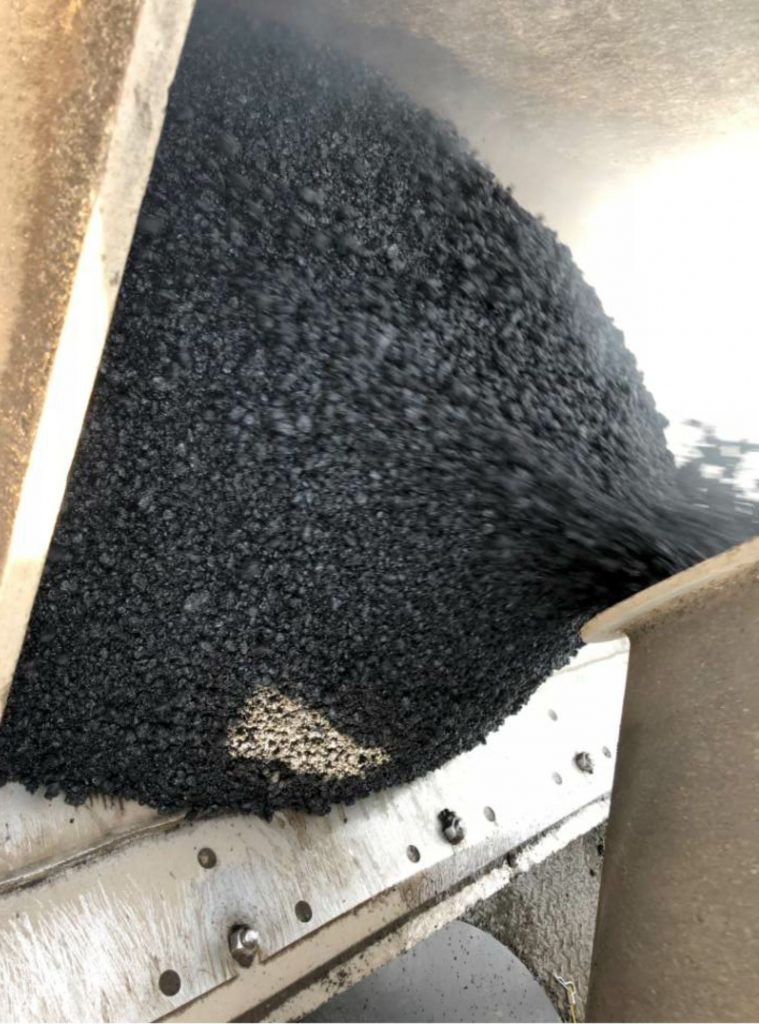
The workers for the City of Des Moines made a control batch of recycle mix with 1 gallon of CSS-1 tack emulsion at 340oF. Here it’s poured to a waiting loader bucket.
The final batch included treatment with 2 gallons of CSS-1 and 1 gallon of Delta S rejuvenator, again heating to a temperature between 300-340 degrees F. This mix was placed on a patch at 112 E. 33rd Court as well. During the project, the ambient temperature was 57 degrees F and the sky was overcast. The site again experienced 15 mph winds. Kida shared: “Due to the size of the patch, more material was needed; it seemed to be a good spot to do a side-by-side comparison. No additional benefit was noticed by adding the second gallon of CSS-1. Compaction and workability were the same.”
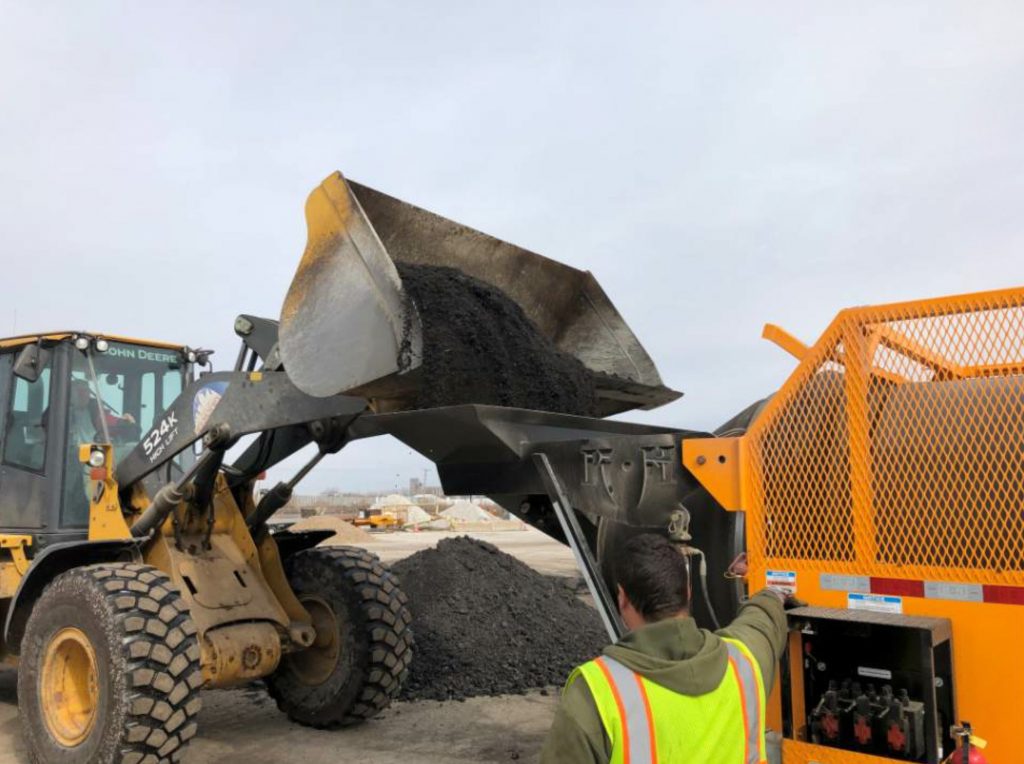
The workers for the City of Des Moines don’t need to weigh the materials precisely for the recycling operation. Here, the loader operator feeds a bucket of one-season-old, crushed millings to the T-2’s hopper.
The City of Des Moines doesn’t weigh the material as it is added to the KM T-2. For the type of patching performed, such precision isn’t required. The workers are getting a restored recycled product by adding 1 gallon of CSS-1 and 1 gallon of Delta S per 1 ton of one-season-old millings. “Roughly, 16 pounds of liquid is being added for 1 ton of material, 8 for the CSS-1 and 8 for the Delta S,” Kida explained.
In the end, the City of Des Moines has a way to revive its material and provide patching for its end users no matter what time of year.
Control Section
Ambient temperature = 39 degrees F
1 gallon of CSS-1 added to RAP
Heated to 340 degrees F
Mix appeared “dull and very stiff”
Compaction = acceptable
Batch 2
Ambient temperature = 54 degrees F
1 gallon of CSS-1 + 1 gallon Delta S added to RAP, heated between 300-340 degrees F
Mix developed “a nice sheen”
Compaction = improved workability
Batch 3
Ambient temperature = 57 degrees F
2 gallons of CSS-2 + 1 gallon of Delta S added to RAP, heated between 300-340 degrees F
Mix developed “a nice sheen” again
Compaction = same good workability as Batch 2
